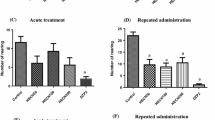Summary
Our earlier studies showed that dihydropyridine calcium channel antagonists have some central pharmacologial effects. Flunarizine is considered to be a calcium channel antagonist; therefore this study was aimed at investigating the effect of flunarizine (given in single doses of 5, 10 and 20 mg/kg p.o.) in behavioural models in which calcium channel antagonists of the dihydropyridine type were previously studied. Flunarizine inhibited the apomorphineinduced stereotypy and yawning behaviour in rats. It decreased the hypothermia induced by a low dose of apomorphine in mice, but not that one induced by high dose of it. The quinpirole-induced hypothermia was also reduced. In the tests used for evaluation of the effect on the serotonergic system, flunarizine decreased the 5-HTP-induced head twitches and partly antagonized the fenfluramine- and quipazine-induced hyperthermias (at a high ambient temperature). In the forced swimming test flunarizine was inactive in mice and rats.
The obtained results indicate that flunarizine exerts central antagonistic effects on the dopaminergic and serotonergic systems and has no antidepressant activity. Funarizine differs from calcium channel antagonists of the dihydropyridine type, which have no dopamine-antagonistic activity and show antidepressant-like properties.
Similar content being viewed by others
References
Auguet M, Delaflotte S, Clostre F, DeFeudis FV (1986) Verapamil as an apparent competitive antagonist of the serotonin receptor of rabbit isolated aorta. Gen Pharmacol 17: 133–135
Bonuccelli U, Piccini P, Paoletti AM, Nuti A, Colzi A, Melis GB, Muratorio A (1988) Flunarizine increases PRL secretion in normal and in migraineous women. J Neural Transm 74: 43–53
Borsini F, Meli A (1988) Is the forced swimming test a suitable model for revealing antidepressant activity? Psychopharmacology 94: 147–160
Chouza C, Scaramelli A, Caamano JL, De Medina O, Aljanati R, Romero S (1986) Parkinsonism, tardive dyskinesia, akathisia, and depression induced by flunarizine. Lancet i: 1303–1304
Corne SJ, Pickering RW, Warner BT (1963) A method for assessing the effects of drugs on the central action of 5-hydroxytryptamine. Br J Pharmacol 20: 106–120
Costall B, Naylor RJ (1972) Possible involvement of noradrenergic area of the amygdala with stereotyped behaviour. Life Sci 11: 1135–1146
Czyrak A, Mogilnicka E, Maj J (1989) Dihydropyridine calcium channel antagonists as antidepressant drugs in mice and rats. Neuropharmacology 28: 229–233
Czyrak A, Mogilnicka E, Siwanowicz J, Maj J (1990) Some behavioral effects of repeated administration of calcium channel antagonists. Pharmacol Biochem Behav 35: 557–560
Di Chiara G, Corsini GU, Mereu G, Tissari A, Gessa GL (1978) Self inhibitory dopamine receptors: their role in the biochemical and behavioural effects of low doses of apomorphine In: Roberts PJ, et al (eds) Advances in biochemical psychopharmacology, vol 19. Raven, New York, pp 275–292
Di Renzo G, Amoroso S, Maida P, Canzoniero L, Nappi C, Taglialatela M, Annunzia L (1988) Effect of different Ca2+ entry blockers on dopamine-induced inhibition of in vitro prolactin secretion. Eur J Pharmacol 146: 201–206
Fadda F, Gessa GL, Mosca E, Stefanini E (1989) Different effects of the calcium antagonists nimodipine and flunarizine on dopamine metabolism in the rat brain. J Neural Transm 75: 195–200
Faunt JE, Crocker AD (1987) The effect of selective dopamine receptor agonists and antagonists on body temperature in rats. Eur J Pharmacol 133: 243–247
Godfraind T (1988) Pharmacological basis of the classification of calcium antagonists. Acta Otolaryngol [Suppl] (Stockh) 460: 33–41
Govoni S, Di Giovine S, Moresco RM, Battaini F, Trabucchi M (1988) Effect of chronic calcium antagonist treatment on dopamine recognition sites in rat striatum. Neurosci Lett 87: 173–177
Grebb JA (1986) Nifedipine and flunarizine block amphetamine-induced behavioral stimulation in mice. Life Sci 38: 2375–2381
Holmes B, Brogden RN, Heel RC, Speight TM, Avery GS (1984) Flunarizine a review of its pharmacodynamic and pharmacokinetic properties and therapeutic use. Drugs 27: 6–44
Mogilnicka E, Czyrak A, Maj J (1987) Dihydropyridine calcium channel antagonists reduce immobility in the mouse behavioral despair test; antidepressants facilitate nifedipine action. Eur J Pharmacol 138: 413–416
Mogilnicka E, Czyrak A, Gołembiowska K, Maj J (1988 a) Effects of some calcium channel antagonists and the calcium channel agonist BAY K 8644 in pharmacological models related to dopaminergic activity. Psychopharmacology 96 [Suppl]: 364
Mogilnicka E, Czyrak A, Maj J (1988 b) BAY K 8644 enhances immobility in the mouse behavioral despair test, an effect blocked by nifedipine. Eur J Pharmacol 151: 307–311
Murphy KMM, Gould RJ, Snyder SH (1984) Regulation of (3H)nitrendipine binding: a single allosteric site for verapamil, diltiazem and prenylamine. In: Scriabine A, Vanov S, Deck K (eds) Nitrendipine. Urban and Schwarzenberg, Baltimore, pp 107–115
Olesen J (1989) Possible mechanisms of action of calcium antagoniusts in migraine prophylaxis. In: Abstract book of 4 th International Symposium on Calcium Antagonists: Pharmacology and Clinical Research. Florence 1989, Fondazione Giovani Lorenzini, pp 35–37
Porsolt RD, Bertin A, Jalfre M (1977) Behavioral despair in mice: a primary screening test for antidepressants. Arch Int Pharmacodyn Ther 229: 327–336
Porsolt RD, Anton G, Blavet N, Jalfre M (1978) Behavioural despair in rats: a new model sensitive to antidepressant treatments. Eur J Pharmacol 47: 379–391
Puech AJ, Chermat R, Poncelet M, Doare L, Simon P (1981) Antagonism of hypothermia and behavioral response to apomorphine: a simple, rapid and discriminating test for screening antidepressants and neuroleptics. Psychopharmacology 75: 84–91
Shah AB, Poiletman M, Shah NS (1983) The influence of nisoldipine-a “calcium entry blocker” on drug induced stereotyped behavior in rats. Prog Neuropsychopharmacol Biol Psychiatry 7: 165–173
Sulpizio A, Fowler PJ, Macko E (1978) Antagonism of fenfluramine-induced hypothermia: a measure of central serotonin inhibition. Life Sci 22: 1439–1446
Author information
Authors and Affiliations
Rights and permissions
About this article
Cite this article
Czyrak, A., Mogilnicka, E. & Maj, J. Some central pharmacological effects of the calcium channel antagonist flunarizine. J. Neural Transmission 83, 179–188 (1991). https://doi.org/10.1007/BF01253388
Received:
Accepted:
Issue Date:
DOI: https://doi.org/10.1007/BF01253388




